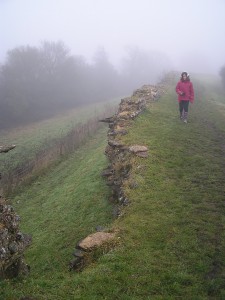(From the programme of the Bramley and Little London Music Festival, June 2011)
IF WALLS COULD SPEAK: ST JAMES’S CHURCH AND THE EMPEROR NERO
Bramley and Little London’s glorious parish church dates largely from the mid-1100s and contains notable fragments of its original murals – almost universal in medieval churches, but largely lost elsewhere – including a scene of the murder of Becket. The very walls of St James’s are thus redolent of tradition and continuity. Concealed behind the exuberant medieval paintings, there is even the possibility of a link with the Emperor Nero.
The 12th-century builders must have been intrigued and baffled by the ruins, at nearby Silchester, of a once-mighty city – the work of giants, it was said, or of the Devil. Who else could have built the formidable walls, up to eight metres in height, that surrounded it? The Saxons had never colonised the place, fearing its mournful atmosphere and its ghosts.
The site had nevertheless yielded much detritus and occasional treasure, including gold coins. Some seemed to bear the name of the ‘giant’ king, Onion. There were great quantities of dressed stone, including that from the defensive outer walls, for the taking; and the plough regularly uncovered the fallen-in roofs of the houses, with their distinctive red tiles. These proved particularly useful to the builders of our church, who imported them by the cartload to Bramley, mixing them with flint to make up the three-feet-thick walls of the new nave and chancel.
Since the 18th century, it has been understood that Silchester was a Roman city, identifiable with the Calleva Atrebatum of the Antonine Itinerary, and that the legendary Onion was probably a misreading of ‘Constantine’. Calleva has now been excavated with greater thoroughness than any other town or city in the Empire. Many magnificent objects have been discovered – from fine mosaic floors to the famous bronze eagle on which Rosemary Sutcliff based her novel, The Eagle of the Ninth – yet none, perhaps, is as evocative as those humble tiles.
They were clearly made from local material, and in 1926 Colonel Karslake of Silchester, a diligent amateur archaeologist, identified the remains at Little London, in a field opposite ‘The Plough’, of the tilery that was probably their main source. One of Karslake’s finds, a roller-patterned flue-tile, is from the period between 80 and 200 A.D.
Karslake claimed that another of his finds (now lost) bore a round stamp with the name of the Emperor, ‘NER.CL.CAE.AVG.GR.’ (Nero Claudius Caesar Augustus Germanicus – the notorious Emperor Nero, 54-68 A.D.). Something similar had already been discovered in the baths at Calleva. The Little London tilery may thus have been an imperial concern, with the concession to satisfy most or all of Calleva’s requirements for tiles and bricks.
The particular fascination of the tiles (displayed in the Silchester Gallery at Reading Museum) is that many bear marks, inscriptions or even footprints. Each would be shaped in a wetted wooden mould and left to dry on the factory floor. The tile-maker would test its consistency with his finger-tips, leaving a distinctive impression. From time to time – much to his annoyance, no doubt – people and animals strayed into his yard, stepped carelessly on the wet tiles and left their footprints to harden in them and be preserved for all time. Among the culprits were a dog, a cat, a deer, a calf, a lamb, an infant and a man with a hob-nailed sandal, who had perhaps reeled out of an early forerunner of ‘The Plough’.
Remarkably and unexpectedly, the Silchester tiles are also evidence of the tile-maker’s literacy, for there are specimens on which he has written. Someone in the factory used an unbaked flue-tile as a surface for writing. He was an erudite man: the inscription ends with a quotation from Virgil’s Aeneid: conticuere omnes – ‘all fell silent’. The text was probably meant to be copied as part of an on-the-job writing lesson, for tilers needed to keep written tallies. One tile is signed – fecit tubul[os] Clementinus (‘Clementinus made this flue-tile’), whilst a large brick is inscribed with the word Satis – ‘Enough’. These are truly Silchester’s equivalent of the Vindolanda tablets: intimate and personal, they are a hand-written evocation of life in Roman Britain.
RUPERT WILLOUGHBY
